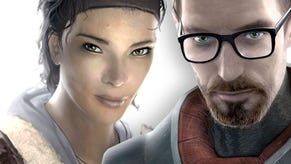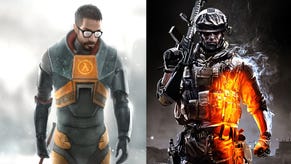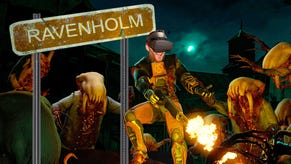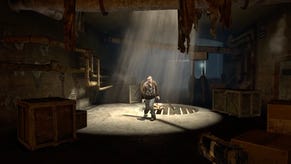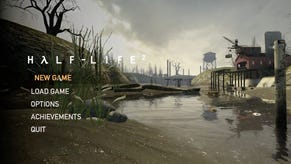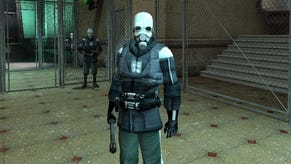Half-Life 2
Moves the goalposts. With a gravity gun.
Rob's take on Life
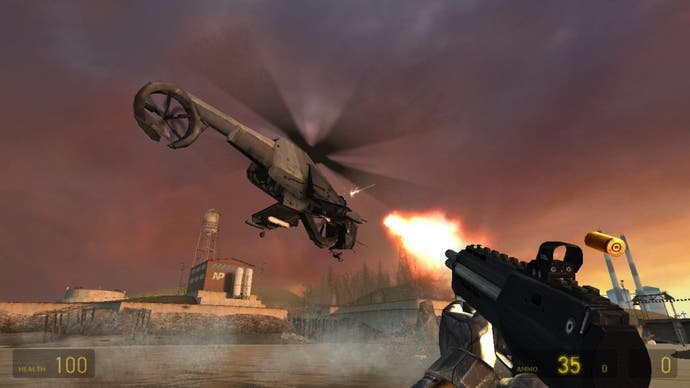
It's a rare game that can survive its own hype. By the time the familiar Valve logo appeared, we were already exhausted. A year - no, a year and a half - of non-stop rumours, and reports, and accusations, and recriminations, and Gabe Newell's soundbites on every website in the world.
It felt like we'd run a marathon with this game already, gone ten rounds with it in the ring. The game itself, it seemed, no matter how good, would just be the punctuation at the end of the world's longest and most tedious sentence. Whether it was a full stop, an exclamation mark, or a question mark (or, if this was to be anything like Halo 2, a semi-colon hanging in space with no sign of the sentence being completed any time soon - but I digress) wouldn't really matter. We'd remember the botched launch, the hacking, the lawsuits and all the ranting about Steam for longer than the game itself. History would repeat itself.
We're not here to talk about that. We're here to talk about the game. It's just hard to talk about the game without talking about the hype, about the delays, about all the things that have hammered Half-Life 2 into our consciousness in a bad way for the past year and a half.
It's just as well, then, that somehow that all evaporated in the seconds between the Valve logo going away and the first menu screen appearing. In the background, City 17, rendered in real-time, with birds flying, troopers walking the streets, and telegraph wires swaying gently in the breeze. In the foreground, it just says HALF-LIFE. It's here. It's on our screens. Despite ourselves, there's a tingle of anticipation, like a virginal first date. We've seen the pictures on the Internet, we've talked about it for years, but tonight is the night. We pray that Half-Life 2 doesn't have a headache. Or an STD.

After a cryptic and spine-tingling introduction from the G-Man, we start on a train. This is familiar ground, but yet unfamiliar - Valve, it transpires, is toying with our assumptions. The train ride lasts seconds, and then we're dumped in a cavernous railway station; the iconic Half-Life train section is in here, all right, but you won't see it for many hours yet, and when you do you'll appreciate it all the more.
What strikes us first about Half-Life 2?
Strangely, it's not the graphics. The graphics are stunning from the outset, certainly, but Valve keeps its powder dry, treating us to more and more sumptuous vistas as the game progresses. Little details like dust motes in the light which streams through high windows and rippled reflections off polished floor tiles might catch your eye, but they seem so natural that only a graphics fetishist will stop to stare. You feel almost guilty about this; those effects probably took ages to program and design, but you wander through them, simply accepting them as being one of the myriad ways in which Valve's world is brought to life. There's a truth about beautiful graphics here; the best special effects are the ones the audience doesn't notice.
No, what strikes us first is the characters. The faces, to be precise. The bearded, fatherly face of Dr Breen beaming down from a huge screen in the railway station, lecturing the oppressed people of the city on the masterplan of their alien "benefactors", each phrase accompanied by a finely judged expression, an utterly realistic inclination of the head or motion of the hands. The resigned expressions of the passengers who shuffle through the station, who look up to observe you as you approach and then slump back down again as you depart. The cheerful visage of the first ally you'll encounter, Barney - remember him? - as he talks, smiles, winks, and runs the gamut of facial expressions from laughter to terror.

They all seem real. They all move like real people; they can walk sideways, and backwards, without looking like ice skaters. They turn to face you when they talk, they look back at you over their shoulders as they walk ahead of you. Their faces express their emotions more clearly than any dialogue ever could. There is a moment, later in the game, where you join a firefight in a warehouse and clear out the attacking troops. The drawn, pale faces of your fellow fighters, who have been defending this location for hours, their numbers thinning with every wave of enemies, rob your victory of any jubilance. You walk over to the injured man they are attending, and they look up at you, wordlessly. It's a moment of revelation. Games can do this. They can use the most subtle storytelling tricks in the Hollywood book without having to drop into letterboxed cut-scenes, and then they can invent some of their own that go far beyond what any director has ever imagined.
After your early encounter with Barney, you wander the streets and buildings of City 17; soak up the atmosphere of the place, such as it is. Then it all kicks off; there is a headlong race through a tenement, a rooftop chase, a heart-pounding opener to the action of the game as you run, without HEV suit or weapons, from a veritable army of pursuers. You'll have your suit soon, and we challenge you not to shiver when the Half-Life music plays as you don it, and from here on, the action doesn't let up. Nearly twenty hours of finely balanced action, in fact - not too many weapons, but certainly not too few. Not too many different enemy types, but certainly not too few. Puzzles which are surprisingly intuitive and genuinely fun to complete. Characters - both friend and foe - that act and move realistically. Vehicles that tread the fine line between being too solid to be fun, and too loose to be controllable, and come out feeling just about right.
The puzzles are worth a mention in their own right; Half-Life 2 has, after all, got the most impressive physics ever seen in a videogame, and it's not afraid to flaunt them. You can lift, throw and push just about anything in the game; so can your opponents, although disappointingly they don't use this ability as often as you might like, which can make their AI seem disappointing. Certainly, the game cheats a little; it sets up opportunities for you to drop heavy things on the heads of opponents with unabashed glee, but then again, that doesn't stop it being insanely satisfying when you run into a room and evaluate the situation in time to knock out just the right supports and take out your enemies in a sea of explosive barrels, falling logs, or collapsing floors. The puzzles, meanwhile, are less a matter of lateral thinking, and more a matter of remembering that this game world performs like the real world; play with relative weight and buoyancy and you'll have the solution to most problems in your hands.
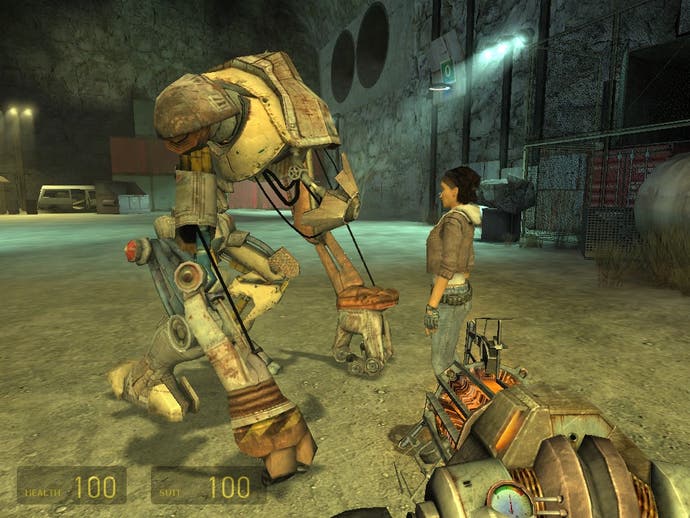
With twenty hours of gameplay, variety is the spice of life. There are sections on foot and sections in vehicles, certainly, but it doesn't stop there. Valve has heard of genres, but it doesn't hold with the concept. Why should Half-Life 2 be pigeonholed as a science-fiction FPS game? Leaving aside the vehicle sections entirely, the game hops effortlessly between genres, touching upon almost the entire set of FPS varieties which have emerged in recent years, and proving itself the master of each and every one. The lone gunman science-fiction sections are present and correct, of course; but the game is equally capable of doing a fantastic job of the horror genre with a set of headcrab-zombie filled levels in a desolate village filled only with the howls of the victims and the raving of an insane priest, or of showing up the entire Call of the Men with Medals of Honoured Duty of Valor genre with a stunning set of levels where you lead a combat squad around a war-torn city. Why stop there, though? Valve didn't; they invent whole new gameplay sections that no other game has ever done. We challenge anyone to resist the urge to howl "Fly, my pretties!" in the assault on the prison complex (for reasons which we'll leave it up to you to discover), while cackling with glee at the weapon handed into your disposal - and the havoc it wreaks on the most basic concepts of FPS gameplay - in the climactic final sections of the game is practically mandatory.
Half-Life 2 is everything that Valve promised, and then some. Certainly, it is buggy; we experienced altogether too many crash bugs for our liking (although Kristan and the unusually silent Tom report no such issues), and graphical and sound corruption was an issue. The load delays are also disappointing, after Half-Life got this all so fundamentally right; but these are minor flaws. Crashes to the desktop merely gave us a chance to tell someone else on the Internet how amazing the game is, grab another coffee and perform some RSI-reducing exercises on our painful wrists. Not that we're suggesting they're a useful feature, but in any other game they would have given us fits of rage. Half-Life 2 is like digital Ecstasy; it can stand on your feet and elbow you in the ribs, but you'll still smile like an idiot and give it a hug.
Standing back and looking at it after having finished the game, there are just too many memorable moments to mention, and far too many of them would be spoilers anyway. Suffice it to say that Half-Life 2 has astonished us from start to finish. Valve has done to the FPS genre what restaurants in Chinatown do to ducks; shredded it, smothered it in a delicious sauce of their own devising, and served it up in a way which you simply couldn't have imagined when looking at them in the pond. The storytelling and character development is subtle and sublime, the gameplay varied, tense and exciting, the graphics stunning beyond belief. The best FPS game ever made? Oh yes, oh yes indeed. While the rest of the world is still scrabbling to catch up with the original Half-Life in many ways, Valve have just moved the goalposts again - and changed all the rules of the game in the process.


